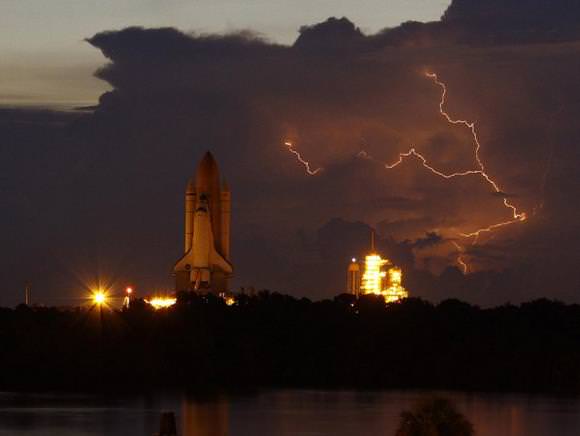[/caption]
Yikes! No wonder the rollout of space shuttle Discovery took a little bit longer than usual. Lightning lit up the sky above Kennedy Space Center early Tuesday morning, providing a stunning backdrop for the shuttle’s crawl to the launchpad. Usually the trip takes about six hours, but various weather-related concerns slowed the move out past 11 hours. Lightning delayed Discovery’s exit from the Vehicle Assembly Building for about 2 hours, and then mud from recent thunderstorms forced the crawler to stop repeatedly so engineers could clean out the giant treads on the huge 5.5 million-pound (2.4 million-kg) vehicle that hauls shuttles out to the launch pad. Discovery is scheduled to launch on August 25 for the STS-128 mission to the ISS. Of interest is that this mission will bring the C.O.L.B.E.R.T treadmill to the station, an exercise device named after comedian Stephen Colbert.
Discovery will carry the Leonardo supply module to the International Space Station during STS-128, along with several refrigerator-sized racks with equipment and supplies, and a new crew member for the station, Nicole Stott. The mission will be commanded by veteran astronaut Rick “C.J.” Sturckow, along with Pilot Kevin Ford and Mission Specialists Patrick Forrester, Jose Hernandez, John “Danny” Olivas and Sweden’s Christer Fuglesang.
Source: NASA


Awesome picture!
At spaceflightnow.com there are other pics of the rollout. Especially one with a meteor overhead. Very impressive!
Thanks!
Too much photoshop contrast reduction in the meteor one though, yech.
The tankside views are impressive, it’s not a common angle. It gives it a steampunk look, almost. Guys actually *ride* this?
By the way, an unrelated question I’ve never found an answer to: why does the shuttle do this rotation in the first seconds of flight? Why not directly launch in the proper position?
that has to be the wallpaper of the year! breathtaking picture!
@ Manu
The first few seconds of flight go straight up, but you can’t go on in that position forever. I would say that the stress on the vehicle (and the pressure on the passengers) is just going too high if you go straight up.
Also the roll-manouver brings the shuttle (the rocket) on the right course where it’s heading to; that it goes into the correct orbit with the correct inclination and so on. It wouldn’t work if you go straight up at first and when you reached your correct altitude then you start to push the vehicle in a direction perpendicular to your previous motion.
And this is another point: Since directions of motion are independent of each other you would need to push your rocket twice (once to reach the altitude and once to gain the orbital velocity). So, by flying the “hypotenuse” of the (imagined) triangle you save fuel.
Why the shuttle flies heads-down, that I don’t know.
Thanks Dr Flimmer, but I think maybe I didn’t ask my question clearly enough. I agree of course the Shuttle can’t go straight up.
But, considering launches always go east + some inclination, let’s say roughly in a NE-SE quarter, why were the pads built facing south?
With a pad facing east, you would need a roll manoeuver (thanks for the proper name) of at most 45°. Facing south, it can be as much as 135° for a NE launch, such as seems the case with ISS launches (or are there SE ISS launches too?). And I’m sure no Shuttle will ever launch due south…